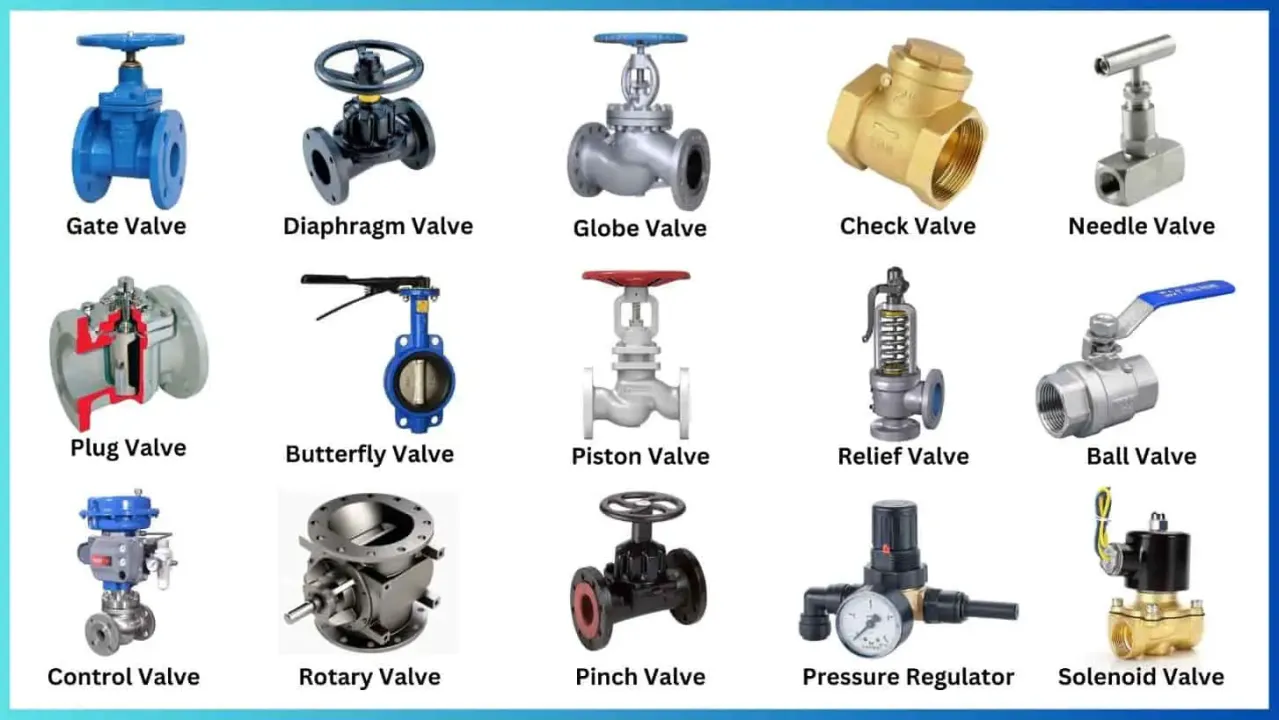
In this article, we have explained all the valves that we will see on ships under a single subject.
Gate Valves
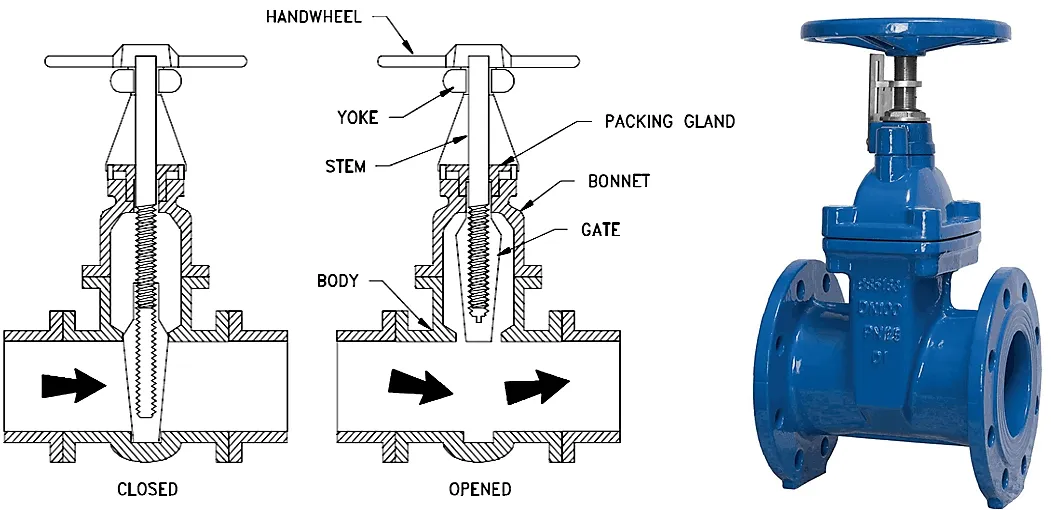
A gate valve is a type of valve that controls the flow of fluid by raising or lowering a gate or wedge inside the valve. The gate, typically a flat or wedge-shaped component, is positioned perpendicular to the direction of the fluid flow. When the gate is lifted, it allows fluid to pass through, and when it’s lowered, it blocks the flow.
Key characteristics of gate valves include:
-
On/Off Control: Gate valves are primarily used for isolating or stopping the flow of fluids. They provide a tight seal when fully closed.
-
Straight-through Flow: When fully open, gate valves allow an unobstructed, straight-line flow of the fluid, minimizing pressure drop.
-
Less Resistance: Gate valves generally have lower fluid resistance compared to some other types of valves, which makes them suitable for applications where low pressure loss is critical.
-
Full Bore Design: The internal diameter of the valve is the same as the pipeline, ensuring minimal obstruction to the flow path.
Gate valves are commonly used in applications where a tight shut-off is required, such as in high-pressure and high-temperature systems. However, they are not typically used for throttling or regulating flow because the abrupt opening and closing of the gate can cause wear and damage to the valve over time. Instead, gate valves are well-suited for situations where the valve is either fully open or fully closed.
Globe Valves
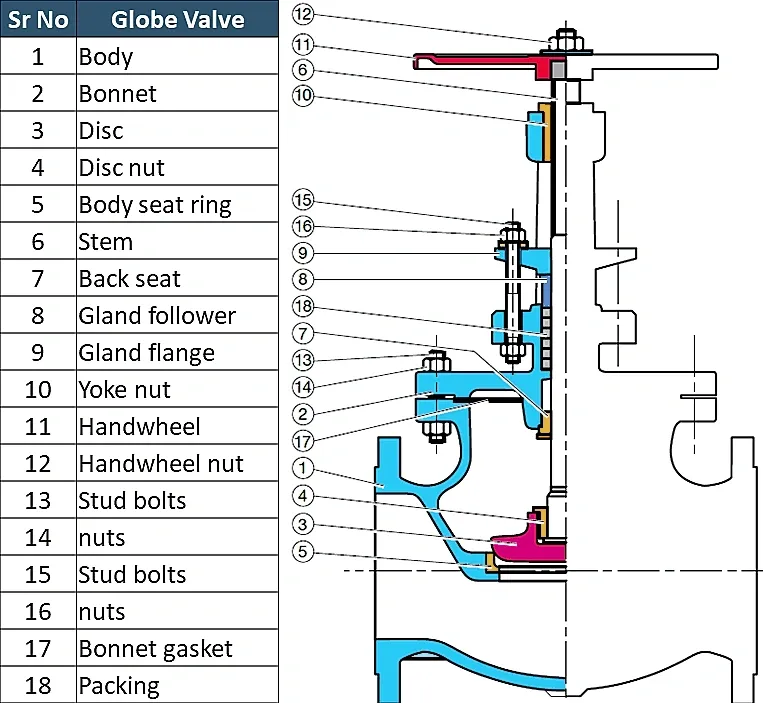
A globe valve is a type of valve used to regulate or throttle the flow of fluids within a pipeline. It is named for its globe-like body shape. The key components of a globe valve include a movable disk (or plug) and a stationary ring seat. The disk is connected to a stem, which is actuated to raise or lower the disk, thereby controlling the flow of fluid through the valve.
Key features of globe valves include:
-
Regulation of Flow: Globe valves are designed for precise control of fluid flow. They can be used to throttle or regulate the amount of fluid passing through the valve.
-
Linear Motion: The stem and disk move in a linear motion, perpendicular to the direction of flow. This allows for fine adjustments in the opening size, making globe valves suitable for applications where flow control accuracy is important.
-
Versatility: Globe valves can be used in a variety of industries and applications, including water supply systems, steam systems, oil and gas pipelines, and more.
-
Bidirectional Flow: Globe valves are often bidirectional, meaning they can regulate flow in both directions.
-
Reduced Pressure Drop: The design of globe valves can help reduce pressure drop across the valve, making them suitable for applications where maintaining a certain pressure is important.
Globe valves are commonly used when precise control of flow is required, as opposed to simply opening or closing the flow like gate valves. They are suitable for applications where throttling or modulating the flow is necessary, and they find use in both high and low-pressure systems.
Ball Valves

A ball valve is a type of quarter-turn valve that uses a hollow, perforated, and pivoting ball to control the flow of fluids through it. The ball has a hole or port through its center, and when the port is in line with both ends of the valve, the valve is open, allowing fluid to flow. When the ball is rotated 90 degrees by the valve handle, the port is perpendicular to the ends of the valve, and the valve is closed, stopping the flow of fluid.
Key characteristics of ball valves include:
-
Quick On/Off Operation: Ball valves offer fast and reliable shut-off with a quarter-turn of the valve handle.
-
Minimal Pressure Drop: The full bore design of ball valves provides a large, unobstructed flow path, resulting in minimal pressure drop across the valve.
-
Versatility: Ball valves are suitable for a wide range of applications, including water, oil, gas, and various other fluids. They are available in different materials and configurations to meet specific requirements.
-
Bidirectional Flow: Ball valves are typically bidirectional, meaning they can control the flow of fluid in both directions.
-
Durability: The simple design of ball valves contributes to their durability and reliability. They are often used in applications where frequent operation is required.
-
Low Maintenance: Ball valves are known for their low maintenance requirements, making them a popular choice in various industries.
Ball valves are commonly used in industrial, commercial, and residential applications where quick and reliable shut-off is essential. They are employed in a wide range of industries, including oil and gas, water treatment, chemical processing, and HVAC systems. Additionally, ball valves are available in various types, such as floating ball valves and trunnion-mounted ball valves, each designed for specific applications and pressure conditions.
Butterfly Valves
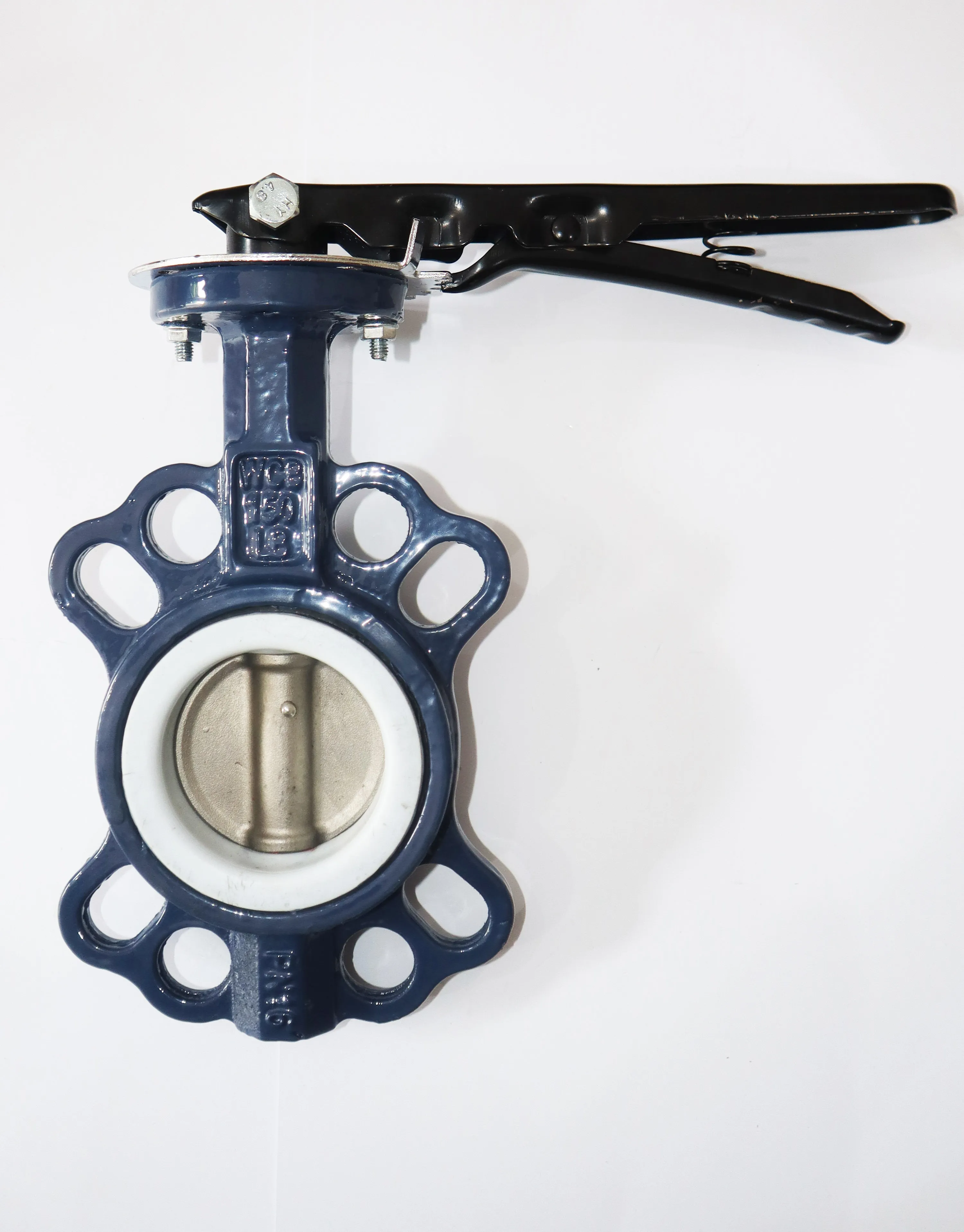
A butterfly valve is a quarter-turn rotational motion valve that is used to control the flow of fluid within a piping system. It consists of a flat, circular disc or “butterfly” that is mounted on a rod. When the valve is in the open position, the disc is parallel to the flow of the fluid, allowing it to pass through. Conversely, when the valve is closed, the disc is turned perpendicular to the flow, blocking it.
Key characteristics of butterfly valves include:
-
Quick Operation: Butterfly valves can be opened or closed with a 90-degree rotation of the disc, providing fast and efficient control of fluid flow.
-
Simple Design: Butterfly valves have a relatively simple design, consisting of fewer parts compared to some other types of valves, making them cost-effective and easy to maintain.
-
Compact Size: Butterfly valves are often more compact and lighter than other types of valves, making them suitable for applications with space constraints.
-
Low Pressure Drop: The streamlined design of the disc allows for a relatively low-pressure drop across the valve, making them suitable for applications where minimizing pressure loss is important.
-
Bi-Directional Flow: Butterfly valves are typically bidirectional, meaning they can control the flow of fluid in both directions.
-
Versatility: Butterfly valves are used in a variety of industries, including water treatment, HVAC systems, chemical processing, and many others.
Butterfly valves are especially popular in large-diameter applications and systems where cost, weight, and space considerations are important. They are often chosen for applications where a relatively quick and simple means of controlling fluid flow is required. However, they may not be as suitable for precise flow control in comparison to certain other valve types like globe valves.
Check Valves
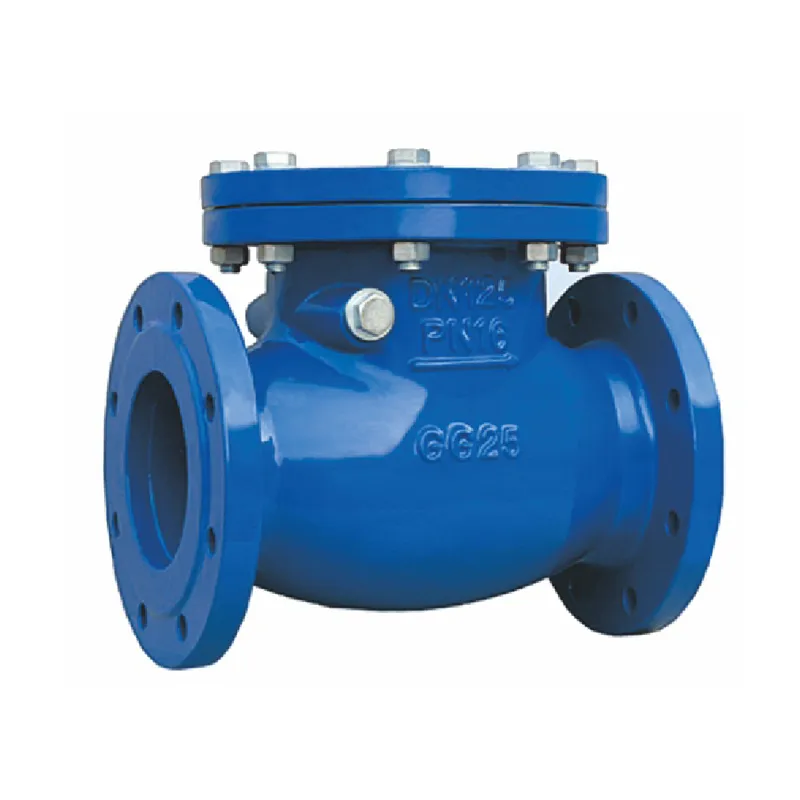
A check valve, also known as a non-return valve or one-way valve, is a type of valve that allows the flow of fluid in one direction only. It has a mechanism that opens to permit forward flow and closes automatically to prevent reverse flow. The primary purpose of a check valve is to prevent backflow or backpressure in a piping system.
Key characteristics of check valves include:
-
One-Way Flow: Check valves permit fluid flow in one direction and prevent it in the opposite direction.
-
Automatic Operation: Check valves operate automatically, relying on the pressure of the fluid to open or close the valve.
-
Various Designs: Check valves come in different designs, including swing check valves, lift check valves, ball check valves, and others. The specific design is chosen based on the application requirements.
-
Minimal Resistance: Check valves typically have low resistance to flow when in the open position, as they allow the fluid to pass through without obstruction.
-
Prevention of Backflow: The primary function of check valves is to prevent the reverse flow of fluids, which can be crucial in maintaining system efficiency and preventing damage to equipment.
Check valves are commonly used in various industries and applications, including water and wastewater systems, oil and gas pipelines, chemical processing, and more. They are installed in pipelines where the prevention of backflow is essential to maintain system integrity and prevent damage to pumps, compressors, and other equipment.
Safety Relief Valves
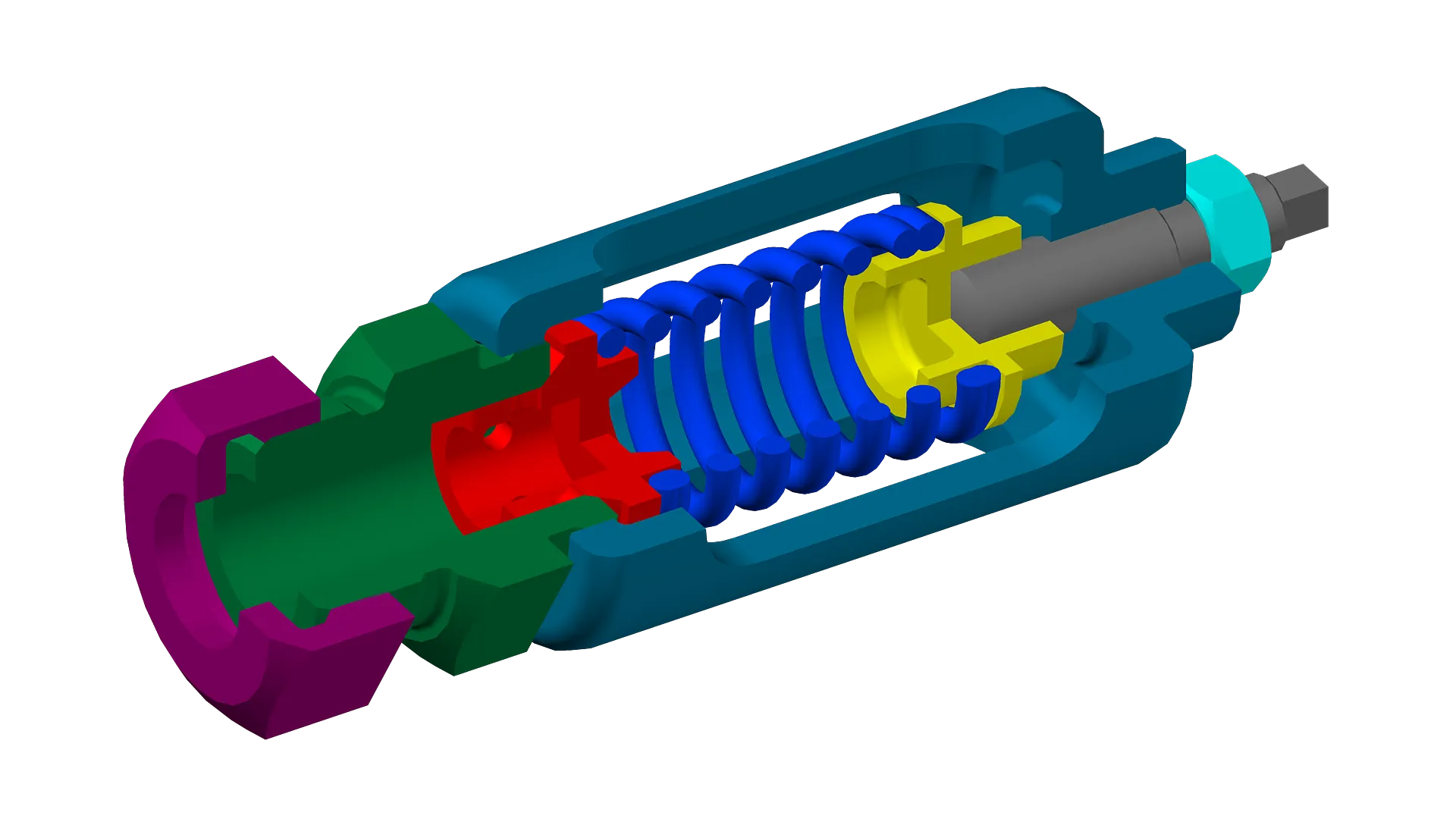
Safety relief valves are critical components in various systems to protect equipment and personnel from overpressure situations. These valves automatically release excess pressure from a system to prevent catastrophic failures. Here’s a brief overview of safety relief valves:
Key Characteristics of Safety Relief Valves:
-
Pressure Protection: Safety relief valves are designed to protect equipment and systems from overpressure conditions by releasing excess pressure to the atmosphere.
-
Automatic Operation: They operate automatically and are set to open when the pressure in the system exceeds a predetermined level.
-
Pressure-Actuated: The valve opens in response to the pressure exerted on it, allowing the escape of fluid or gas until the pressure drops to a safe level.
-
Bidirectional Flow: Safety relief valves are typically designed to handle bidirectional flow, meaning they can relieve pressure regardless of the direction of fluid flow.
-
Adjustable Settings: These valves often have adjustable settings to allow for the configuration of the opening pressure to match the system’s requirements.
-
Critical Safety Devices: Safety relief valves play a crucial role in preventing overpressure scenarios in various applications, including steam boilers, pressure vessels, pipelines, and more.
-
Compliance with Standards: Safety relief valves must adhere to industry standards and regulations to ensure their reliability and effectiveness in emergency situations.
Safety relief valves are commonly found in industrial settings where the release of excess pressure could lead to dangerous situations. They are essential for maintaining the integrity of pressure vessels, boilers, and other systems where pressure control is critical for safety. The proper sizing, installation, and maintenance of safety relief valves are crucial to ensure their effectiveness when needed.
Diaphragm Valves
A diaphragm valve is a type of valve that uses a flexible diaphragm (a membrane or elastomeric barrier) to control the flow of fluids. The diaphragm is typically a flexible material that can be raised or lowered to either allow or block the flow of the fluid. When the diaphragm is raised, the valve is open, and when it is lowered, the valve is closed.
Key Characteristics of Diaphragm Valves:
-
Isolation and Control: Diaphragm valves are often used for isolating and controlling the flow of various fluids in a pipeline.
-
Simple Design: They have a relatively simple design with few moving parts, making them easy to operate and maintain.
-
Bubble-Tight Seal: The flexible diaphragm provides a tight seal when closed, preventing leakage of the fluid.
-
Resistance to Corrosion: Diaphragm valves are suitable for handling corrosive or abrasive fluids, as the diaphragm material can be selected to resist corrosion.
-
Linear Flow Path: The flow path through a diaphragm valve is typically linear, which can be an advantage in applications where a straight-line flow is preferred.
-
Versatility: Diaphragm valves are used in a variety of industries, including pharmaceuticals, water treatment, chemical processing, and more.
-
Manual or Actuated Operation: Diaphragm valves can be operated manually or with the help of an actuator for automated control.
Due to their ability to provide a tight seal and resistance to corrosion, diaphragm valves are often chosen for applications where preventing leakage and handling corrosive fluids are critical. They are commonly used in situations where precise flow control is necessary, and the simplicity of the design is an advantage.